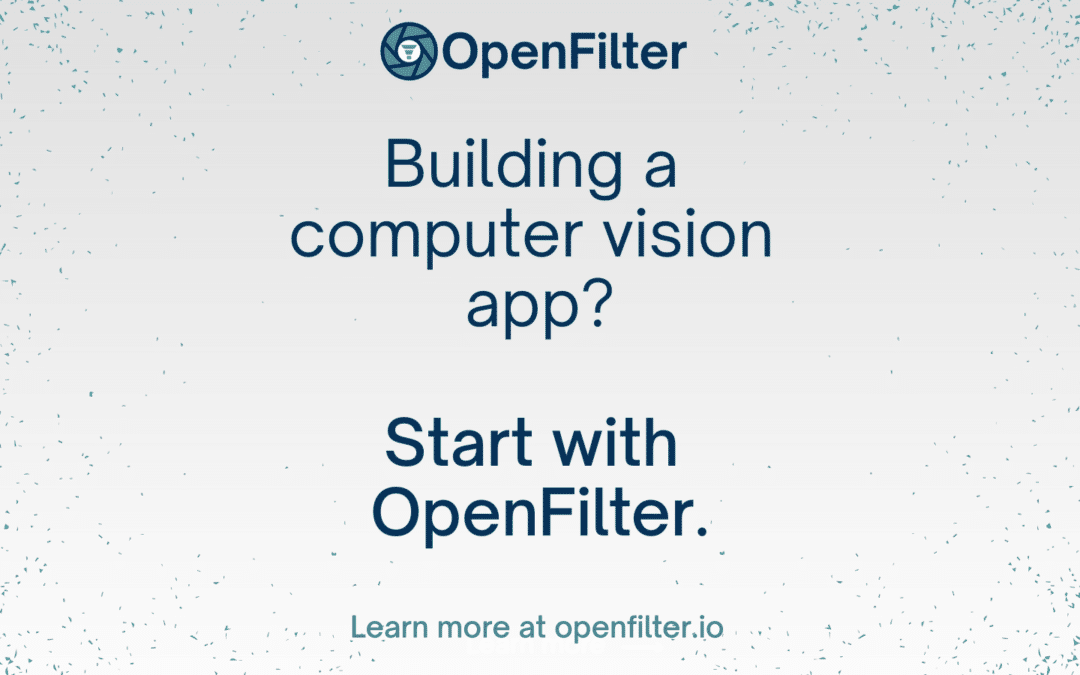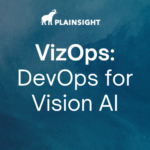Building computer vision apps shouldn’t require a PhD. That’s why we built OpenFilter, an open-source framework for vision that is composable and transparent from day one.
Plainsight incubated OpenFilter and launched it on May 21, 2025, at the Embedded Vision Summit. After getting tired of duct-taping vision projects into existence, we decided to make it easier and build a shared foundation.

What Is OpenFilter?
OpenFilter is an open-source framework for building computer vision workflows through modular, composable building blocks called Filters.
A Filter is a universal abstraction that represents a unit of vision workload. It can encapsulate a machine learning model, traditional computer vision logic, utility functions, or even testing and evaluation tools. Each Filter is self-contained, with its own lifecycle and dependencies, which makes them easy to mix, match, reuse, and chain together.
Not every vision task needs deep learning. That’s why OpenFilter is designed to work just as well with algorithmic techniques as it does with modern ML models, giving you the freedom to build what fits your needs.
The framework includes:
- An open-source Filter Runtime for executing and managing Filters
- Simple installation via Python Wheels
- A library of utility Filters and practical examples: object tracking, counting, segmentation, preprocessing, and more
- Support for both RTSP video streams and batch image inputs
- Pipeline templates and Filter specification examples to help you get started
Whether you’re rewriting builds or plugging into existing tools like PyTorch, OpenCV, or YOLO, OpenFilter helps you create vision workflows with less friction and more flexibility.
Why Now?
A big part of the problem lies in the disconnect between AI and cloud developer communities. AI practitioners build bespoke, specialized applications, hard-coded for a singular task and environment. Cloud engineers, by contrast, design for uniformly treating applications as stateless abstractions.
Without cloud engineers approving the application’s deployment architecture and pipeline to infrastructure, it won’t scale. By that point, foundational design choices have already been made, and retrofitting the bespoke AI application for scale, reliability, and maintainability becomes a costly and painful endeavor.
What makes this disconnect even more frustrating is that the infrastructure does exist. We’re living in a moment of unprecedented availability: GPUs are more accessible than ever, powerful foundational models are ready off the shelf, and vibrant ML communities are constantly creating new models. Everything needed to build production-grade computer vision applications is already here, except the architectural bridge between experimentation and deployment. If AI systems were designed from the ground up presuming scalability (modular, stateless, and observable), that transition from proof of concept to deployment wouldn’t be the end of the project. The bottleneck isn’t tooling or computing. It’s knowing how to build like it’s going to production from day one.
OpenFilter changes that. It gives developers a way to compose and evolve their workloads without starting from zero each time. It stays flexible, replicable, and designed to support the messy, practical reality of working with visual data.
Treating Vision Like a First-Class Workload
Vision isn’t just another AI task. It comes with distinct challenges:
- High-throughput, often continuous video input
- Spatial and temporal logic
- Complex chains of logic across multiple frames or feeds
These aren’t just model-level challenges, they’re architectural. Yet many tools treat vision like a one-size-fits-all problem, forcing it into abstractions built for text or static images.
OpenFilter flips that perspective. It treats vision as a first-class workload, deserving of its own tooling. That means pipelines designed for live video. Filter chaining that supports streaming. Simple ways to plug in both lightweight logic and heavy models. And full visibility into how your data flows, frame by frame, stream by stream.
Who Is It For
OpenFilter is built for anyone working on vision problems, whether you’re experimenting with new ideas, refining prototypes, or assembling reliable, replicable workflows.
It’s especially useful for:
- Developers & researchers who want to prototype CV apps without rewriting build
- Open source contributors who want to shape the next-gen vision dev ecosystem
- Solution providers who want to evaluate before engaging commercially
- Enterprises who need a bridge from open experimentation to production-grade deployments

What Makes It Different
Unlike commonly employed vision libraries or one-off model wrappers, OpenFilter provides the architecture to build scalable, modular pipelines. It introduces a true runtime abstraction, letting you filter, manage, and chain together inputs and outputs with full control. It’s flexible enough to integrate with the models and tools you already use (like YOLO, OpenCV, or custom frameworks), but powerful enough to serve as the backbone of a deployment. No model lock-in. No vendor lock-in. No rewrites. Just adaptable infrastructure.
Built for Collaboration, Shaped by the Community
OpenFilter is not just a toolset, it’s a community project. It’s open-source from the start and welcomes contributions from researchers, developers, and educators. Filters built to solve specific problems, like detecting PPE compliance on job sites or verifying packaging labels in a warehouse, can be reused and extended by others tackling similar issues. That shared progress helps eliminate redundancy and makes OpenFilter stronger over time.
By prioritizing composability and transparency, OpenFilter helps avoid the “black box” trap that slows down innovation. It doesn’t assume one way of working, it gives you the flexibility to define what matters for your application and the tools to make it happen.
Ready, Set, Contribute!
Whether you’re debugging a warehouse camera, labeling agricultural data, experimenting with footage from your garden, or evaluating before engaging commercially, OpenFilter gives you the tools to move faster and build better with confidence.
Visit openfilter.io to learn more and join the community to explore what’s possible when computer vision tools are democratized.




